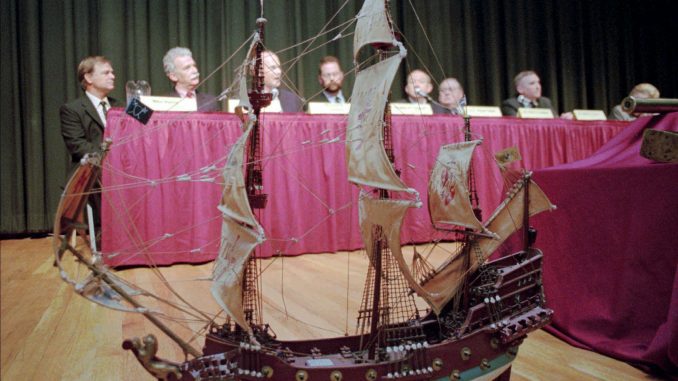
GREENVILLE — Blackbeard’s plunder has become a precious bounty for preservationists.
Since the remains of the Queen Anne’s Revenge were found 22 years ago, state conservators have recovered thousands of metal parts from the pirate’s sunken ship, including cannons and a 12-foot-long anchor.
But they are dealing with a bigger challenge — preserving the vessel’s wood.
Storms, strong currents and shipworms have destroyed all but a few remaining pieces of the famed ship, which sunk 300 years ago.
“There isn’t much wood left,” said Sarah Watkins-Kenney, director of the Queen Anne’s Revenge laboratory based at East Carolina University’s West Research Campus near Greenville.
“What we do have is very precious.”

Divers have found 35 pieces of ship planks, 11 frame fragments, a 1,600-pound sternpost and other tiny wooden bits. The longest plank is just over 13 feet. The sternpost, which is the bulkiest, will one day be a featured piece of the Queen Anne’s Revenge exhibit at the North Carolina Maritime Museum in Beaufort, N.C.
Blackbeard’s vessel originally was a French slave ship, La Concorde. The first record of it shows up in 1710, said curator Kimberly Kenyon. Blackbeard commandeered the ship from the French in 1717, renamed it the Queen Anne’s Revenge and terrorized the North Carolina coast before running his vessel aground in the summer of 1718. He was killed on another ship near Ocracoke in November of that year.
Intersal Inc. found the remains of Blackbeard’s ship off Beaufort, N.C., in 1996 and later turned them over to the North Carolina Department of Natural and Cultural Resources. The lab will host its annual open house next year on April 6.
Preservation of every artifact requires years of work, but wooden objects are the most fragile.
“You have to keep them wet,” Watkins-Kenney said.
Over years, water replaces the cell structure of submerged wood, Watkins-Kenney said. The lumber looks fine at first, but begins to deteriorate soon after it is removed from the water. Every piece must be submerged in a tank quickly.
“Our task is to stabilize them,” she said. “That gives us time to do research.”
The treatment of a 5 1/2-by-4-inch oak piece that was used to patch a hole in the ship is typical. Divers brought up the wooden fragment in 2000, Kenyon said. It remained stored in a water tank for three years awaiting the preservation process. Over the next five years, conservators frequently changed the water, withdrawing salt from the wood. Then it underwent chelation, a process used to remove iron left by nails.
For another three years, the fragment soaked in water mixed with polyethylene glycol, or PEG, a waxy substance that penetrates the wood, replaces the water and solidifies the structure. PEG has been used to preserve large shipwrecks such as the Vasa in Sweden and the Mary Rose in Portsmouth, England. The patch then went through a freeze-drying process to safely remove the remaining moisture before finally being displayed in 2016.
Through a microscope, researchers saw remnants of animal hair and black tar used to caulk the patch, Kenyon said.
“You could still smell the pitch of the pine tree,” she said.
The sternpost, where the rudder would have attached, has been soaking for 11 years. The piece measures about 8 feet tall and 6 feet wide and has parts of oak, pine, lead and iron. Each metal and each type of wood gets different treatment, Watkins-Kenney said. PEG may not penetrate where lead lines the edge.
Conservators are not sure if they should treat the entire post or take it apart, preserve each section and put it back together, she said.
“We’re not sure we can get it back together exactly,” Watkins-Kenney said.
Precision is key, Kenyon said. A Roman numeral six was carved into the wood at a point just short of 6 1/2 feet from the bottom. A foot in France was 12.75 inches at the time, a clue to its origin. The number marked a spot that helped navigators know how deep she sat in the water.
It may take another 10 years to finish the sternpost and decades before the recovery and preservation of the entire site is complete, Kenyon said.
“I suspect I will not see the end of the project,” said Kenyon, 37. “It takes decades. It’s just the nature of conservation.”
